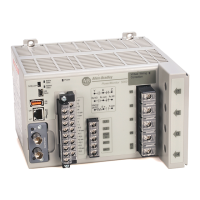96 Rockwell Automation Publication 1426-UM001J-EN-P - August 2019
Chapter 5 Power Quality Monitoring
Harmonic Analysis
The PowerMonitor 5000 provides harmonic data to help you understand this
important element of power quality in your facility. When calculating harmonic
analysis results, the M5 and M6 models use DC to the 63rd harmonics, and the
M8 model uses DC to 127th. Individual harmonic results are not provided in the
M5 model.
For additional harmonic analysis, including interharmonics, see EN 50160
Conformance Tracking on page 473.
Setup
Only basic metering setup is required.
Operation
This section describes the methods for measuring harmonics.
IEEE and IEC Total Harmonic Distortion
These total harmonic distortion calculation methods provide a summary
indication of the amount of distortion due to harmonics present in a system.
The standard IEEE definition of harmonic distortion is ‘Total Harmonic
Distortion (THD)’ and is computed for each voltage (V1, V2, V3, VN) and
current (I1, I2, I3, I4) channel as follows:
The standard IEC definition of harmonic distortion is the Distortion Index
(DIN) and is computed for each channel as follows:
Crest Factor
Crest Factor is another measure of the amount of distortion present in a
waveform. This measurement can also be used to express the dynamic range of a
measurement device. Crest Factor is the ratio of the peak to the RMS.
A pure sinusoid Crest Factor equals .
THD
∞
Σ
n2=
H
n
()
2
H
1
-------------------------
=
Where:
•H
n
= magnitude of the n
th
harmonic
•H
1
= magnitude of fundamental
DIN
∞
Σ
n2=
H
n
()
2
∞
Σ
n1=
H
n
()
2
---------------------
=
Where:
•H
n
= magnitude of the n
th
harmonic
• DIN is equivalent to IEC THD
Crest Factor Peak Value RMS Value⁄=

